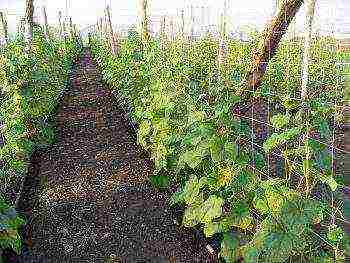Content [show]
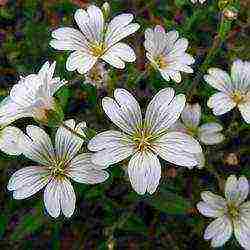 Yaskolka is a perennial plant native to the Balkans, now growing everywhere in temperate climates. In the photo, the chisel looks like a green and white carpet. Gardeners love chickweed for its ease of growing in the open field and absolute unpretentiousness. This flower can live in almost any conditions and is easy to reproduce. And a variety of varieties and species will give you the opportunity to decorate your garden without even being a landscape designer.
Yaskolka is a perennial plant native to the Balkans, now growing everywhere in temperate climates. In the photo, the chisel looks like a green and white carpet. Gardeners love chickweed for its ease of growing in the open field and absolute unpretentiousness. This flower can live in almost any conditions and is easy to reproduce. And a variety of varieties and species will give you the opportunity to decorate your garden without even being a landscape designer.
Yaskolka: varieties and varieties
There are more than a hundred species of chickweed, many of which are considered weedy. In culture, mainly perennial varieties are widespread:
- Jaskolka Biberstein. The most common type among gardeners. Its main advantages include long flowering and rapid growth. In addition, it tolerates light frosts well and does not need a winter shelter. It is a creeping flower with gray-green leaves and medium-sized (about 1.5 cm) white flowers.
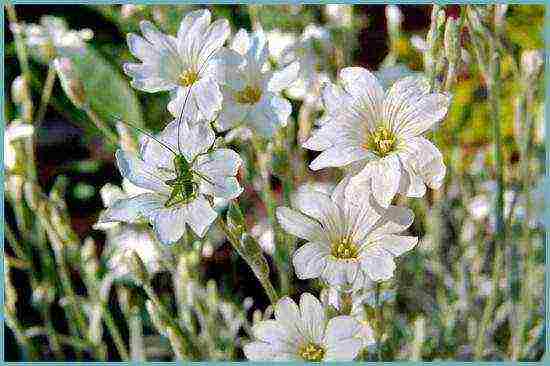
Jaskolka Bieberstein
- Felt yaskolka. One of the favorite colors of professional landscape designers. A short, upward bush with star-shaped flowers on small stems.
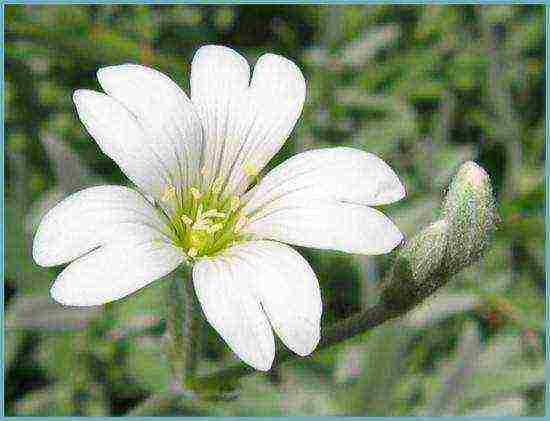
Felt splinter
- Snow-white yaskolka - a silver carpet of flowers. A very spectacular view, blooming from the very beginning of summer.
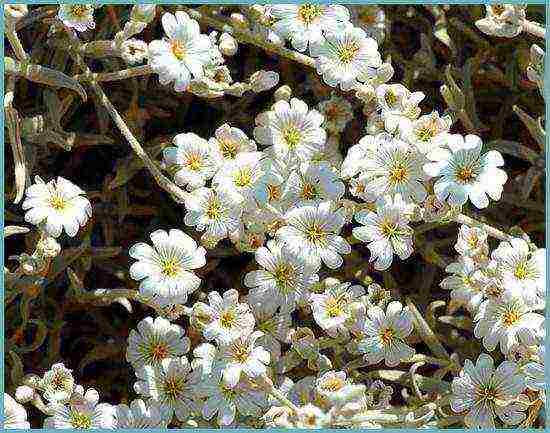
Snow-white yaskolka
- Silver lamb - This is a plant, the flowers and leaves of which seem to be covered with a silver layer. It blooms in early summer, looks very advantageous in an area with direct sunlight.
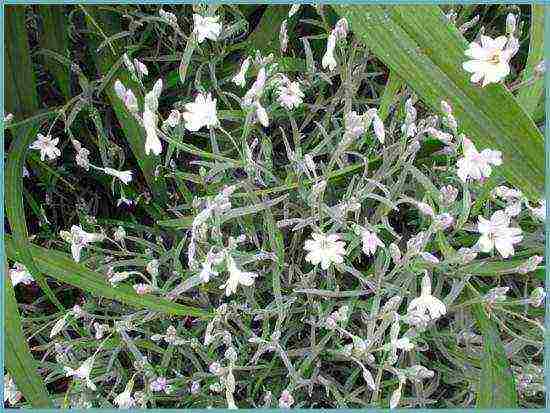
Silver lamb
- Alpine shingle. Of all the varieties, the most unpretentious. It grows in any conditions and on any soil.

Alpine lamb
- Field shingle. It can reach a height of 40 cm, it grows even in the wild. It differs from other species in long (up to 4 months) flowering.
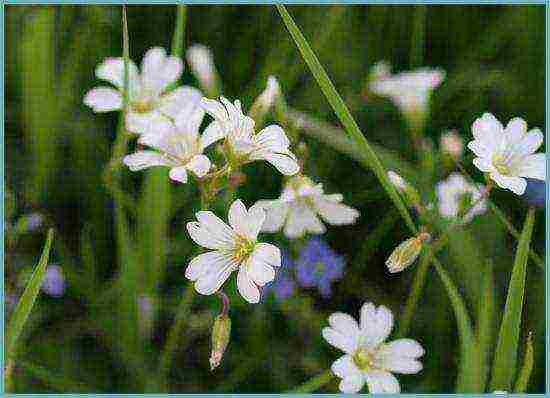
Field shingle
Planting a plant
Perennial yaskolka is characterized by a fast growth rate and is capable of covering a fairly large area with a carpet in a short period of time. As the culture grows, it forms caps or large balls.
You can plant the chick in open ground with seeds. This is usually done in mid-spring. A sunny place is most often chosen for planting, because it is the sun's rays that make the carpet made of chippings so spectacular. Any soil is suitable for this perennial.The only exception is clay, it is better to dilute it with sand. When digging, fertilizer is not applied. They just sow seeds in open ground at a distance of 25 cm from each other and watered with water.

The shingle takes root well on any soil
This planting can be done not only in spring, but also in late autumn.
If you want to achieve an earlier flowering, then it is better to plant seeds for seedlings. Seeds are sown in pots in May, and in June they are transferred to open ground. The optimum temperature for seedlings is 22-23 degrees.
Advice. Do not water your chive seedlings too often. It will be enough to do this every 3-4 days.
Plant care
Why are gardeners so fond of yaskolka? Planting and caring for her is so simple that even the most inexperienced grower can handle them. The main part of caring for a shrub is watering it. It is necessary to water it once a week, not more often. Occasionally it is necessary to loosen the ground near the bushes. If the flower has grown more than you would like, you can trim off the extra stems.
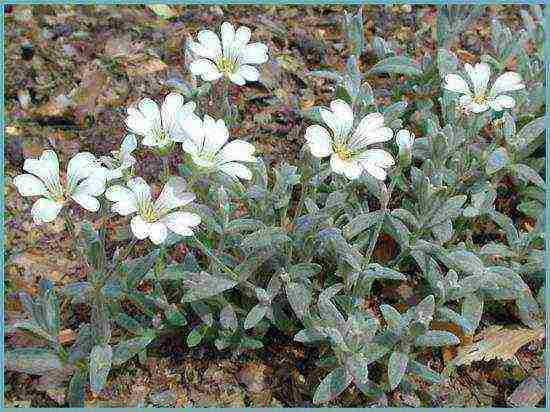
The splinter does not require painstaking care
Advice. When the stalks are cut, the chrysalis often blooms again. If you want to extend the flowering time in the garden, you can use stem pruning.
Many varieties of chickweed are considered frost-resistant, but some are recommended to be covered for the winter with spruce branches or a layer of peat, after cutting off the stems to 1-3 cm.
Fertilization and feeding of chickweed
Many gardeners argue that chickweed does not need additional feeding and fertilization, but there are those who recommend feeding to accelerate growth and more lush flowering. It is often advised to introduce organic matter after planting and during the flowering of a perennial.

The introduction of organic matter will make the flowering more lush
Breeding chickens
A chick, which will not give you any trouble growing and caring for, is also easy to reproduce. For this, the classic methods for all perennial plants are suitable:
- Cuttings. In the spring, even before the plant releases flower stalks, or in the fall after flowering, the cut shoots are rooted in the garden, covered with a cap.
- Division of the bush. In early spring, when the shrub bushes begin to grow, the bush is dug up and divided into parts, which are planted separately from each other.

It is better to propagate the plant in spring.
Advice. If you plan to propagate chickweed by cuttings, then, as practice has shown, June cuttings are more effective than autumn cuttings.
Diseases and pests
Another advantage of the shingles can be attributed to the fact that it is practically not susceptible to diseases and has good resistance to pests. It is only in rare cases that the shrub can undergo a fungal infection. Most often this happens when the plant is completely neglected or with excessive moisture.
Advice. Trim wilted stems periodically. This will give your plant a compact and well-groomed appearance, as well as increase immunity to diseases.

Blossoming chickweed looks like a solid white carpet from afar.
Chickweed: combination with other plants
Since many varieties of chickweed are considered weedy, and those that are grown in gardens have the ability to grow rapidly, this must be taken into account when planting on the same bed with other plants. There is a possibility that some chrysalis plants may simply "crush". To avoid this, it is necessary to prune the stems of the flower.

Yaskolka on a flower bed
Chimney in landscape design
The chimney is widely used in landscape design. Very often it is used as curbs and at the foot of alpine hills.
The flowerbed will look no less interesting, the central part will be the chickweed, and the next circles will consist of plants of other shades. For example, the second circle can be planted from calendula, and the third from bright red tulips. With a border, santbrinks are ideal for such a flower bed.
This ground cover perennial will also look good in rockeries.The silvery leaves of some varieties of jascoli will blend in perfectly with the stones, and also cover up unsightly gray areas in your area.
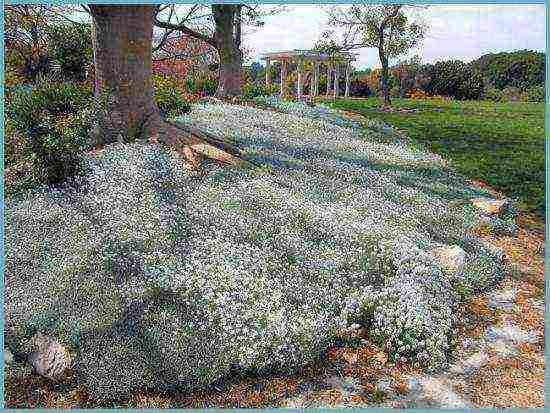
Chimney in landscape design
This flower looks elegant on flower beds with daisies and daffodils, as well as against the background of dark leaves of bells and stonecrops.
Yaskolka is ideal for those who do not have enough experience in growing flowers, as well as for owners who do not live on the site permanently, but nevertheless want to have a beautiful flower garden. It is absolutely not burdensome, but gives the flower beds grace and rich appearance. Apart from the plot, this flower often survives in pots and pots. It brings freshness to any terrace or balcony. And its long flowering and neat appearance make it a favorite of all flower growers.
Growing chickens: video
Types of chives: photo
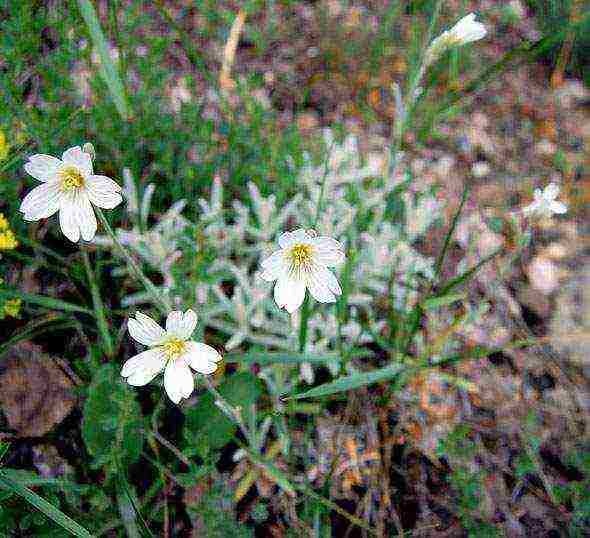
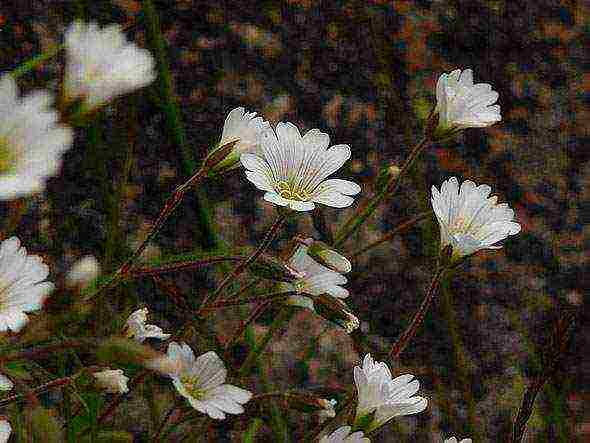



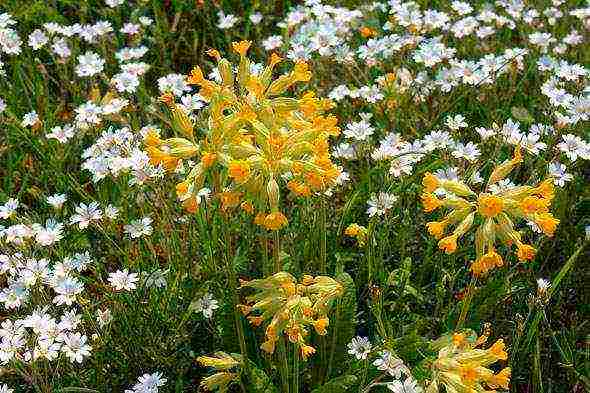

Flowers are the decoration of any suburban area. Many gardeners are familiar with perennials that can add a special charm to any garden. However, the leaders usually remain peonies, lilies or hydrangeas familiar to many. But there is also another rather unpretentious plant. White felt yaskolka is a charming option for a summer residence. Its delicate flowers are usually used to decorate the edge of a flower bed or create a zone decorated with stones.
Other names for yaskolka. Plant appearance
Felt chickweed is also known under the scientific name "cerastium". However, among the people it can also be recognized by the funny name "mouse-ear". This plant belongs to the carnation family, therefore it bears similarities with representatives of this species. The plant itself is perennial, undersized. Its height reaches twenty, less often thirty centimeters. It is worth noting that this flower seems to spread along the ground. Occasionally, specimens can be found that are slightly elevated above the ground.
The flowers of the felted shingle, the description of which is indicated above, are small, but they are densely located on the plant. This gives the impression of a carpet on a grassy surface. Probably, this is why gardeners love this unpretentious plant. By themselves, the inflorescences are like stars due to the pointed ends of the petals. Mostly this plant is white or silvery.
Common types of chive
There are many varieties and varieties of felt felts:
- Bieberstein's jaskolka is one of the most common species of this plant.
- The second place is taken by the Snow Carpet. The name of the plant speaks for itself. Its flowers are arranged randomly, creating a picture of slight negligence.
- Silver chrysalis is another type of unpretentious plant that has a special color.
- The alpine version is also actively used to create landscape design on the site. Its advantages are in particular unpretentiousness. This species stands out even among the rest of the chippings. It can be planted both in the shade and in acidic soil.
Jaskolka Biberstein. Peculiarities
The most common of the species of this plant has white flowers with pointed petals. The diameter of the inflorescence can reach one and a half centimeters, which is quite large for this species. Inside the flower is a yellowish cushion, which looks harmoniously with the light green stems and leaves of the laskolka itself.
It is noteworthy that the Crystal Waterfall felt variety has a similar appearance. However, due to its smaller inflorescences, it is less often chosen to create a site design. However, the latter option is easier to take root in garden plots. Thus, each of the varieties of chickweed has its own advantages.
Snow carpet. Pluses of the species
Yaskolka with a poetic name fully justifies it. If the variety named after Biberstein is clearly white in color, then the flowers of this species have a silver tint. Otherwise, they are similar. What is the abundance of flowering, which is the number of inflorescences - these two varieties are confident leaders.
This option is used for edging existing flower beds.Due to its low growth, this plant is also planted along the paths, and lush bushes are already behind them. Also, this plant tolerates shade well, so it can be placed under fruit trees. The advantage of this plant may also be that it takes root both on the site and at home. That is, it is used for planting in hanging pots. The plant doesn't need a lot of soil. However, at home it is better to provide an additional source of lighting.
Preparing for planting
Why do they love felt felt so much? Planting and caring for it does not require a lot of time and effort. The advantages of the plant are that their seeds, in fact, do not require special preparation. However, those who want to get a lush carpet from this plant still resort to a number of tricks.
If seeds are purchased in stores, you should pay attention to whether the packaging is tightly closed. If there are cuts, bruises, then the purchase should be abandoned. We must not forget about the shelf life of the seed. An expired product can please the buyer in the future with flowers, but this is rather an exception to the rule. Expired seeds have a low germination rate.
If the seeds are taken independently, from an existing plant, then fully ripe specimens should be selected. That is, the plant should bloom, and small and dark seeds appear in place of the petals. They can be taken for further planting.
Where the plant is planted
The place for the felt felt must be chosen in advance. It is worth noting that the plant is very fond of sunlight. It tolerates heat well and the lack of regular watering. Moreover, rocky soil is also his best friend. This allows you to choose places for the chick that are not suitable for other, more whimsical plants.
However, it should be noted that this flower feels good in partial shade conditions. In full shade, for example under trees, the number of flowers can be significantly reduced. However, in any case, the flowering of the felt chick will be noticeable. This again speaks of her non-capricious nature.
Planting a felt felt. Care in the early days
It is better to grow chickweed in seedlings. Of course, no one canceled planting in straight soil either, but this method can reduce the germination of seeds. When planting at home, in peat pots, there is a chance to get a powerful plant.
Sowing a plant at home should be in early spring, then by May it will be possible to transplant already emerged and matured plants into open ground. Further transplanting is not recommended, that is, in the garden, you should immediately choose the place where the flower will remain for a long time.
It is better to moisten the soil before planting the plant. Then the plant will take root faster. Plants are planted at intervals of twenty or twenty-five centimeters.
Primary care is watering, which should not be too abundant. When planting with seeds, cover the planting site with a film or non-woven covering material to provide the plant with an influx of heat. Seeds should be planted in early April. Then by summer the plant will disperse with might and main. After planting, the soil should be thoroughly watered to provide moisture to the seeds.
Plant care
When growing the felt chickweed directly into the open ground, it should be remembered that flowering will be likely only in the third year of the plant's life. Otherwise, flower care is carried out in the same way as when planting seedlings.
The plant is quite unpretentious, therefore, caring for it does not require much time. Watering is carried out once a week, and you can water the entire plant without fear, and not just the root area. There is also no particular need to loosen the soil, since there are practically no weeds near this plant. This is due to the fact that chickweed successfully survives other weaker plants from their area.
Many do not feed this type of plant. However, this is not entirely true.Flowering will be more violent, and the plant will turn green for a long time if you use universal flower dressings. However, if the chrysalis has grown profusely, then fertilization can be abandoned. Otherwise, it can fill up most of the site. Top dressing is carried out in the spring, once a season. A large unpretentious chisel is not required.
It is also worth pruning the plant periodically. Dry or overgrown stems are removed with scissors. This regular pruning can lead to re-flowering of the chive.
You can transplant the plant after three years. The transplant is carried out due to the fact that a plant that has lived for a long time in the same place is stretched out. Because of this, the bush looks slightly sloppy. Therefore, he is rejuvenated by choosing a new place. When transplanting, the plant is completely removed from the ground in spring or autumn. Also, together with a lump of earth, it is planted in a hole in a new place. Water abundantly and leave for a while.
Preparing for winter
The shrapnel does not require special preparation for winter. However, some varieties still recommend covering for the winter. You can also think about shelter if the winters are expected to be frosty, but without much snow.
In this case, a bush of chippings is cut, leaving stumps about five centimeters high, and then they are covered with straw or spruce legs. This helps the plant survive the winter better.
There is also another option. Those who would like to get an already formed bush from early spring can use a non-woven material. In this case, the plant is not cut, but completely covered. The shelter is removed immediately after the snow melts. After that, the plant can be rid of dry or knocked out shoots.
Felt chickweed is a beautiful perennial plant. Its small shoots are used as decoration for plots. Also, thanks to this flower, you can achieve a pleasant and well-groomed appearance of the suburban area and garden. The advantages of the plant are its unpretentiousness. This plant hibernates calmly, does not require special protection measures. Watering and pruning of the stems should also be done rarely, which allows the shrub to remain a favorite of summer residents.
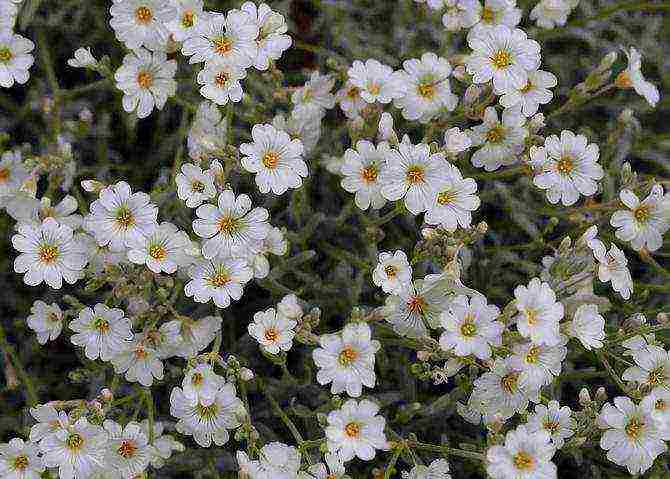
Cerastium - this is the scientific name of Yaskolki, it represents the family of carnations. A special charm to this creeping plant is given by the appearance of a velvet "cap" knitted of small silvery-white flowers. The shpolka has erect ascending stems with a fringe; it actively grows, forming tufts. At the end of flowering, the plant forms an oblong seed-fruit with small brown seeds.
Popular types
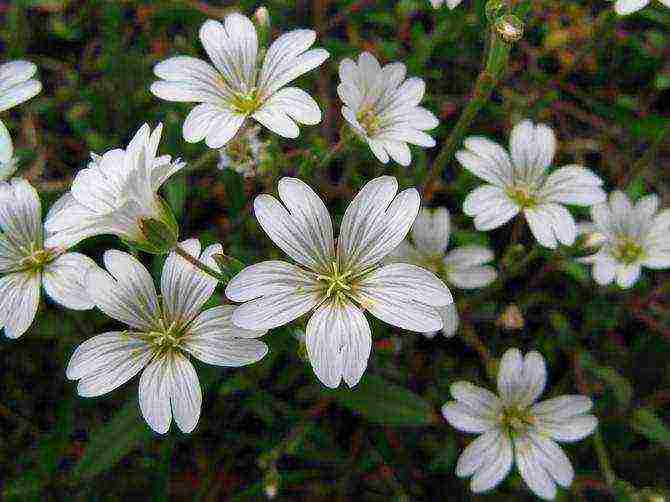
In the wild, it is found on the African and Australian continents, in America and Eurasia. The plant has about two hundred species, which include both one- and perennials. In Russia, only a small number of them have found distribution:
- Field shingle. Unpretentious, stems reach a height of 45 cm, leaves can be oblong or spear-shaped. Inflorescences range from single to group.
- Alpine. White flowers bloom in May. Ground cover, stems are about 10 cm high.
- Large-flowered. It is proud of larger flowers than other species - up to 3 cm.
- Bibirstein. Stems densely pubescent, up to 20 cm high, resistant to low temperatures, early flowering. It grows actively and can even displace other plants from the flower bed.
- Terry stem. One of the most beautiful species, its homeland is Italy. Forms compact cushion curtains that rise 30 cm above the ground.
Rules for growing felt felt
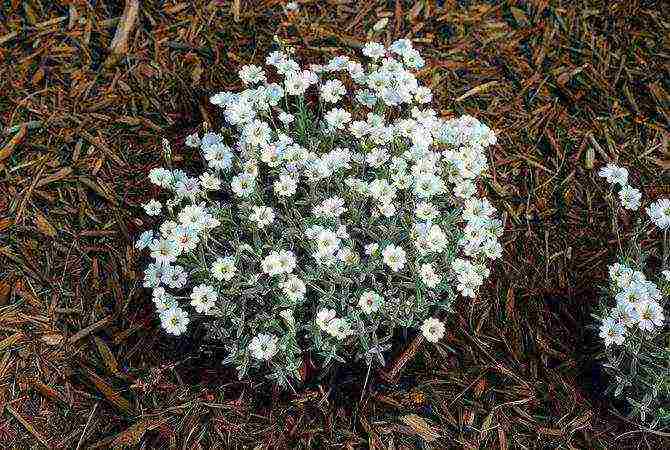
This type is also very popular. It has branchy stems of gray-green color, which, growing, form a high (up to 30 cm) pillow. Flowers are white, up to 1 cm in diameter, appear in May. The flowering period lasts about 35 days.
Felt chickweed is a non-capricious plant. But for better decorativeness, you should know some of the features of planting and care.
Choosing a landing site
The felt type of chickweed is photophilous, drought-resistant and winter-hardy. This must be taken into account when determining the landing site. The best will be a plot on a hill, where the maximum sun rays during the day. In semi-shaded areas, the plant will also feel normal.
Important. You cannot choose a dark place for the chick, especially where there is a lot of moisture. There she simply will not survive.
Any soil is suitable for the plant: stony, sandy, poor. The main condition should be good drainage so that the soil is not waterlogged. If the soil is too dense, sand should be added to it so that the water does not stagnate.
Sowing seeds
Sowing material is applied to the soil either at the end of October or in April. You can also use the seedling method. For this, the seeds are sown in early March. Containers with future plants should be placed in the brightest place, optimally on the south window.
Young shoots sprout after 10 days. When three real leaves appear on them, the chick dive into separate cups of 2-3 stalks. If the sowing was in open air nurseries, the seedlings should be thinned out so that the gaps between them are at least 5 cm.
From the premises, the young are transferred to open ground in mid-May, and at the end of June - from nurseries. It happens that chickweed blooms in the first year, but usually flowers appear only the next.
In the process of growing, the seedlings are watered rather moderately, avoiding an excess of moisture.
Care of the felt felt
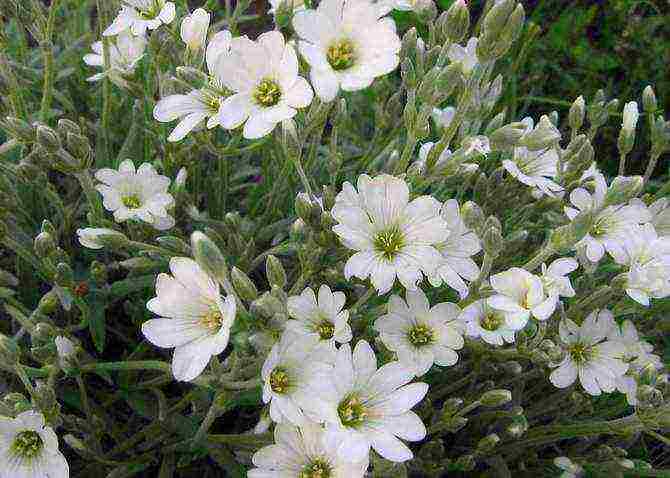
Watering
There is practically no need to water the felt wool - a dense carpet will retain moisture and the leaves from below will begin to rot. Natural moisture is sufficient for the plant to develop well.
Important. Watering the chickworm is needed only if the weather is too dry and hot, and only a few times per season.
Transfer
After three years, the flower needs to be transplanted to rejuvenate the plant, since over time it loses its decorative qualities. The stems stretch out and the bush becomes messy.
To maintain its shape, the cap is trimmed. In the process of pruning, long shoots are removed, which are knocked out of the general "head" of the bush.
Important. To maintain decorativeness after flowering, the stems must be cut off.
Top dressing and fertilization of chickweed
The chickweed can do just fine without fertilizers. But if you still want to pamper her, you can use a universal composition for ornamental plants. By feeding the flower once at the beginning of summer, you will provide the chick with everything it needs.
Wintering a flower
The plant tolerates frost well. If you have correctly selected the planting site, then there is no need to cover the flower with anything. Some of the shoots even retain their foliage and actively recover in spring. It is worth covering the chickweed with spruce branches or dry straw only when there is a threat of severe frosts, and there is no snow cover.
Advice. If you have a desire to admire full-fledged bushes in the spring, cover them with non-woven material. They remove it after the snow melts - the bushes will be completely alive. In the spring, the flowerbed where the chickweed grows should be cleaned of plant debris and all dry shoots removed.
Important. If the area with the flower is flooded with melt water, the plant may die.
Reproduction of the felt felted
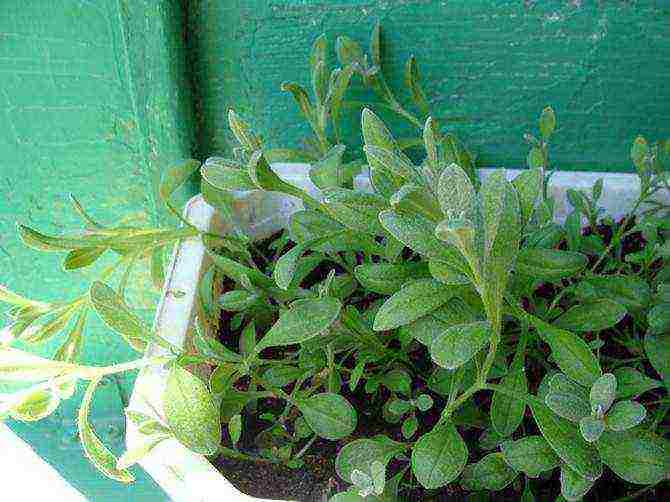
Yaskolka can be propagated not only by seeds, cuttings and division of the bush are also used.
- Division of the bush. The procedure is carried out in the fall or early spring. The bush is divided with a shovel, and each part is transplanted to a new site. The bushes take root well and begin to grow actively.
- Cuttings. After the bush has faded, the stems are cut from it for reproduction. They are planted in the ground, where they quickly take root. Already in the fall, such specimens produce new shoots, and after overwintering, they quickly grow.
Important. The day before cutting the cuttings, the plant needs to be well watered to saturate the stems with moisture.
Diseases and pests
The main method of preventing chickweed diseases is soil moisture normal for it.It should be practically dry. If there is an excess of moisture, the flower will rot. Actually, this is the only disease that threatens the plant. Pests of yaskolke are not terrible.
Jascola in landscape design
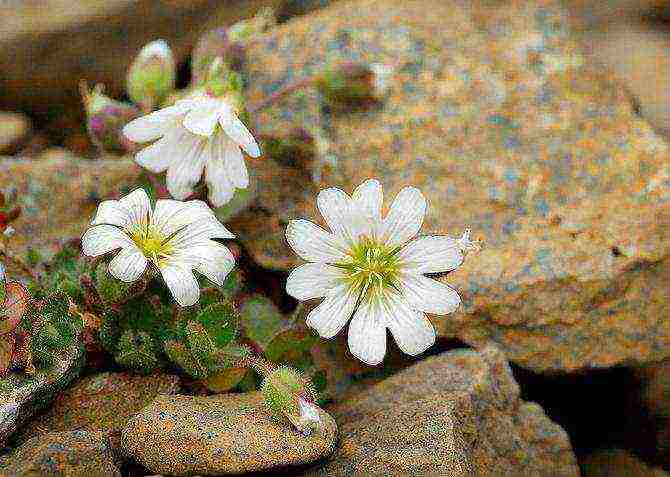
The best location for the jascol is, of course, an alpine slide. In the process of growing, the curtains will wonderfully surround the stones, and the plot will have a natural, pristine appearance. In addition, the flower looks good in the vicinity of geyhera, bells, cineraria, stonecrop, if placed in a flower bed with a low border.
It makes sense to plant the chickweed on bulbous, flowering in late spring - tulips, muscari. When they fade, a lush carpet will cover the dry stems, and now small snow-white stars will delight the owners with their scattering.
Air clouds on a green background can be created by planting a chisel on a lawn. It also looks great on the edge of the garden paths. The neutral white color of the chrysalis makes it possible to match plants of any desired shades to it according to the color palette.
Important. Drought-resistant flowers that do not need frequent watering should be adjacent to the shrub. This is because the moist soil, so needed by other plants, will cause the chickey to rot.
This flower has become very popular with many gardeners. And there is nothing to be surprised at. After all, needing a minimum of care, the chickweed will exquisitely decorate any corner of the garden.
Felt yaskolka - flower care (video)
Yaskolka (Cerastium) is a one - or perennial herb with ascending or creeping shoots. Belongs to the Clove family. The natural habitat is the temperate climatic zone of the Northern Hemisphere. In gardens, it is grown as a ground cover plant.
The leaves are small, attached alternately, pubescent, the ground part has a silvery tint. The height of the bush is 15-30 cm, and in width it can reach 70 cm. During the flowering period, the dense pillow is covered with small (corolla diameter is 2 cm) snow-white flowers with a yellow throat. Blooms in early summer.
Growing chickweed from seeds
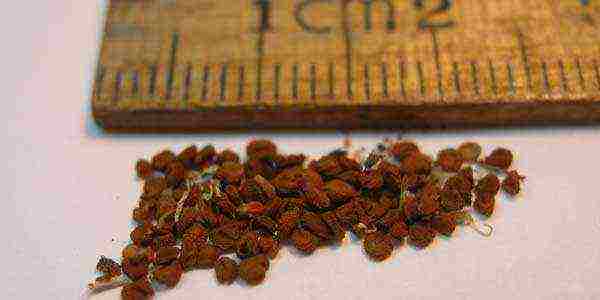
Felt seeds
Jascolka is easy to reproduce. Do this in a seed or vegetative way.
Sowing in the ground: when and how to plant
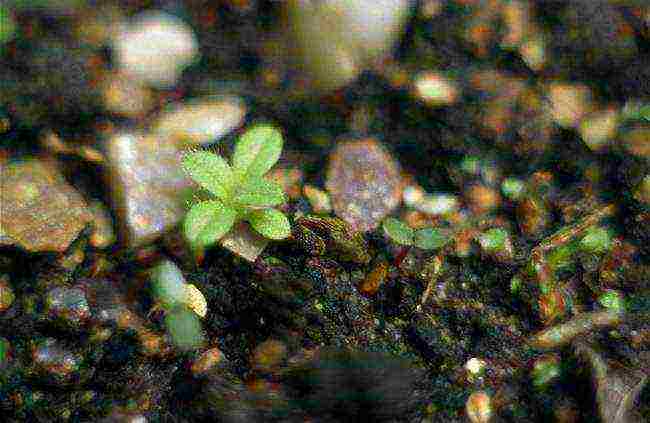
How to sow yaskolka with seeds in the ground photo of seedlings
Sowing seeds in open ground can be carried out before winter in October or in spring in April.
- You can sow chickweed in rows, making shallow grooves at a distance of 15-20 cm, or scatter it over the surface of the bed and close it up with a rake, covering it with a layer of humus on top.
- In the spring, when the seeds sprout, the seedlings are thinned out, leaving 7-8 cm, and when they grow up, the extra seedlings are transplanted, leaving a distance of 15-30 cm between the bushes.
How to grow seedlings

Chick from seeds photo of seedlings
- Sow seedlings in March.
- Fill containers with loose soil, spread the seeds over the surface, moisten the crops, cover with foil.
- Provide ambient lighting and room temperature (22-25 ° C).
- The seeds germinate well, sprouts will appear in about 14 days. Then the shelter can be removed.
- When the height of the plants reaches 5 cm, the seedlings should be transplanted into separate containers.
- Transplant into open ground at the end of May, after hardening the seedlings for two weeks.
- The flowering of the chrysalis from the seeds will come the next year.
Reproduction of chickweed by dividing the bush
Mature bushes can be divided. It is easy to cut the chickweed from the mother plant with a knife or a shovel and transplant to a new place. Ground covers completely entwine the place allotted to them, so you don't even need to try to understand where one bush ends and another begins. Just dig out the cut and replant it to a new site.
Reproduction of chickweed by cuttings
You can root cuttings before flowering or at the end. The best result is obtained in the second case. Cut the cuttings 5-10 cm long, root immediately in the garden bed with shading. Cover the stalk with a jar or cut plastic bottle.Remove the shelter when the sprouts gain strength.
Planting Yaskolya seedlings in open ground
First, select a site. Please note that the bushes grow rapidly, occupying the appropriate area.
Seat selection
Yaskolka can be called one of the most light-loving plants - you should not plant it even in partial shade. Access to bright light is a must for most of the day. It grows well even on the south side under the scorching rays of the sun. Due to its short stature, it is not afraid of the wind.
The soil needs light, loose, sufficiently nutritious. Sandy, sandy loam and even loamy soils are suitable, which should be fed with compost. Can be planted in rocky areas, but add peat to trap moisture.
Soil preparation
Prepare the site a month or at least a couple of weeks before planting. Dig the soil to a depth of about 20 cm, apply fertilizers (5-7 kg of organic matter for each m²). If the soil is heavy, add coarse sand.
How to plant
Dig the soil again just before planting. Make planting holes for the size of the root system. Keep a distance of 15-30 cm between the bushes, water well after planting.
How to care for chickweed in the garden
The plant is unpretentious in care.
- Water about once a week; in severe drought, increase the frequency of watering.
- To keep the soil breathable, loosen the soil periodically. Remove weeds.
- Cut off shoots that are knocked out of the mass or encroach on the territory of neighboring crops.
- Remove faded peduncles - then a solid cushion of a silvery bush will look decorative before winter comes.
- To maintain the strength of the plant, apply a complex mineral fertilizer or a mixture for garden flowering plants 2-3 times per season.
Yaskolka can grow well in one place for a long time, retaining its decorative effect. The transplant is carried out mainly to limit its growth. Repot about every 5 years, dividing the bush can be done more often (every 3 years).
Wintering of chickweed
The plant is winter-hardy - no shelter is required in the middle zone and even to the north. But still, if a particularly harsh winter is foreseen, cut off the shoots, leaving a length of 2-3 cm, mulch the soil with peat, cover with lutrasil or spruce branches on top.
Diseases and pests
With proper care, the plant is resistant to diseases and pests.
From the absence of pruning for many years, regular waterlogging of the soil, fungal diseases may appear. Remove the affected areas, treat with a fungicide.
Types of yaskolka with photos and names
There are more than 100 plant species, consider the most popular perennials.
Jaskolka Bieberstein Cerastium biebersteinii
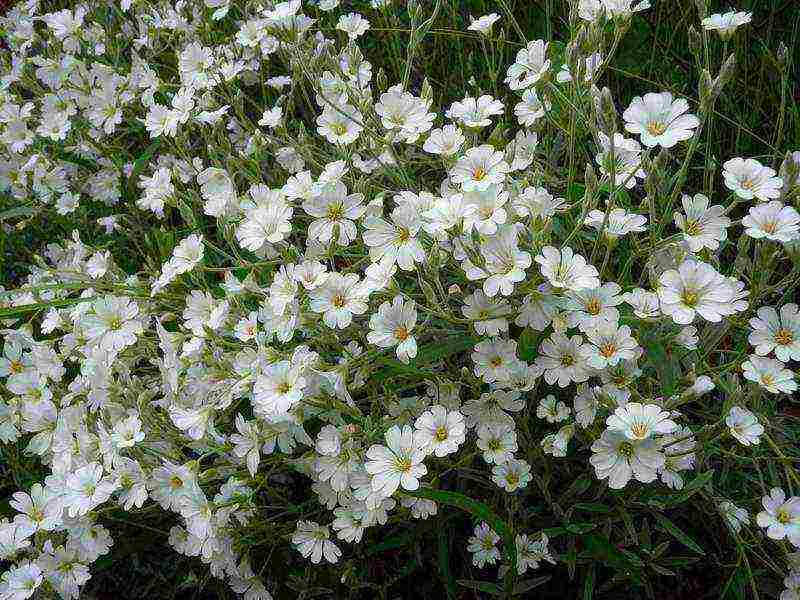
Bieberstein lizard Cerastium biebersteinii photo
The most common type. The ground part of the gray-green color is abundantly covered with small (up to 1.5 cm in diameter) snow-white flowers. Blooms in May-June.
Felt splinter Cerastium tomentosum

Felted splinter Cerastium tomentosum photo
The stems are directed upwards. Shoots and leaves are heavily pubescent. The diameter of the flowers is 1-1.5 cm.
White lizard Cerastium candidissimum
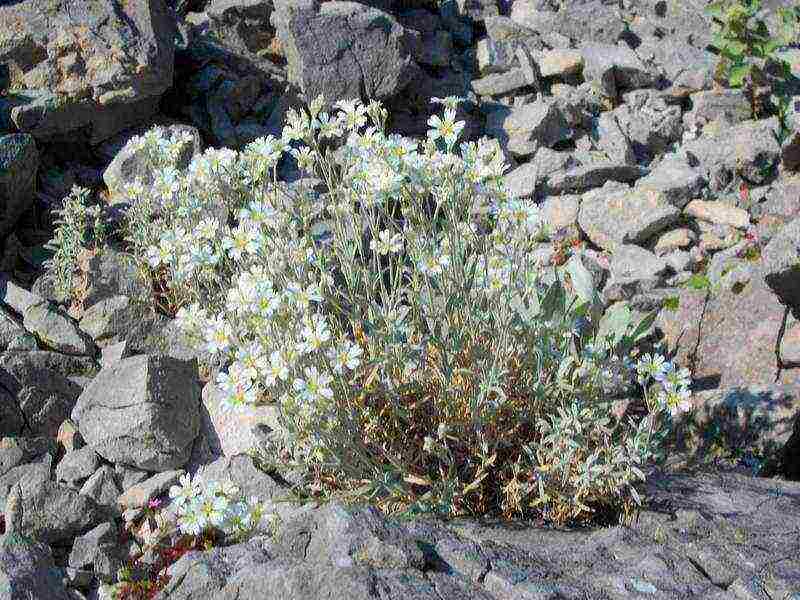
Snow-white louse Cerastium candidissimum photo
It is also called the Snow Carpet - it grows very quickly, creating a solid carpet decorated with small snow-white flowers.
Silver chrysalis Cerastium argenteum
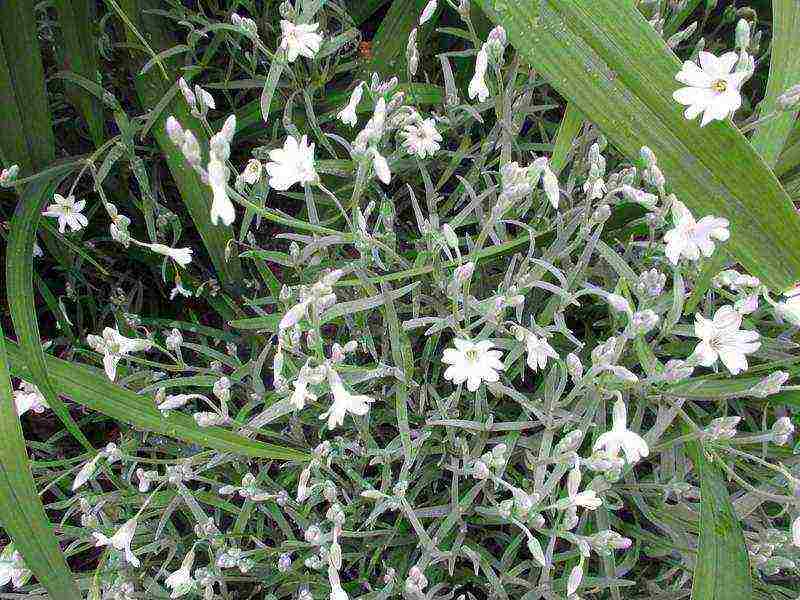
Silver lizard Cerastium argenteum photo
Or Silver carpet - the ground part of the silver color, flowers also have a silver tint. Re-flowering is possible.
Yaskolka silver carpet on video:
Alpine splinter Cerastium alpinum

Alpine splinter Cerastium alpinum photo
A ground cover with a height of about 15 cm. Flowers bloom from the end of spring and delight throughout the month.
Field shingle Cerastium arvense

Field chickweed Cerastium arvense photo of flowers
It can reach a height of 40 cm. The leaves are oblong, the ground part has a juicy green color. The flowers are snow-white.Differs in the longest flowering period - up to 4 months.
Common or key shingle, bone Cerastium fontanum
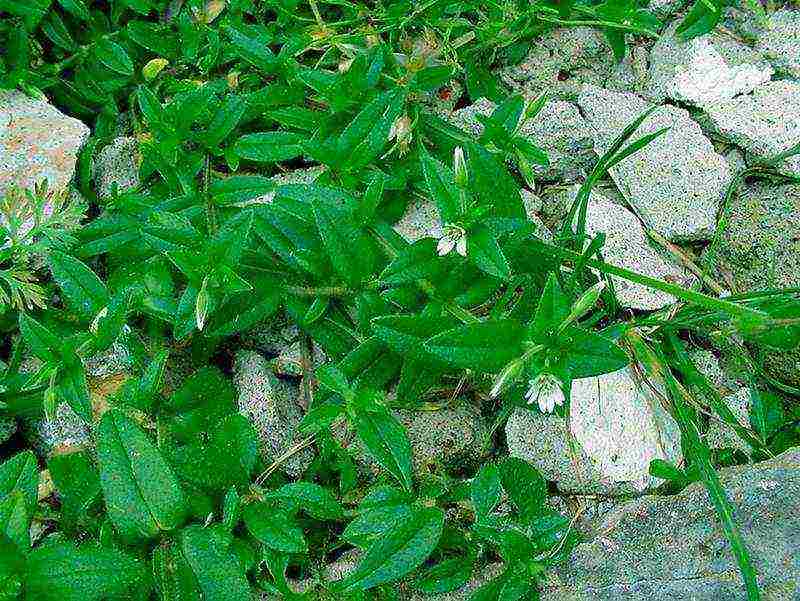
Common or key shingle, bone Cerastium fontanum photo
A creeping plant characterized by polymorphism. The flowers are inconspicuous, rare, white. Leaves are lanceolate, elongated, arranged in pairs on long internodes. The plant has soft pubescence.
Ural shingle Cerastium uralense
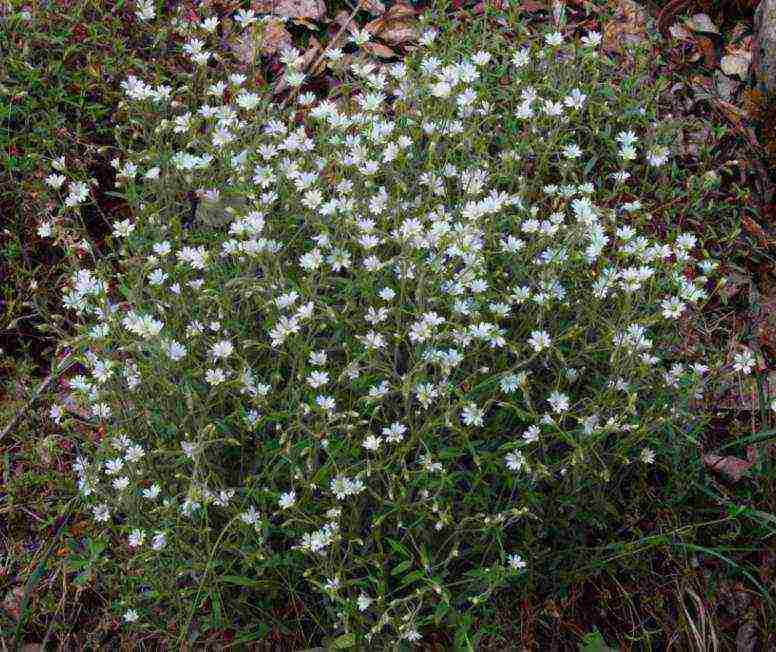
Ural chickweed Cerastium uralense photo
Very frost-resistant species. Long slender erect shoots are rarely covered with narrow long leaves. Flowers are single, 2 cm in diameter. The decorative appearance is achieved through dense plantings.
Jascola in landscape design

Chip in landscape design photo
Yaskolka looks great at the base of alpine hills, on clones, in crevices, near large stones. Good in the foreground of flower beds, in rockeries, mixborders, border plantings, plant along paths, walls.
Plant a chrysalis in the center of the flower bed, the next circle can be a calendula, the next - bright red tulips, finish the composition with septenchinks.

Yaskolka and veronica in a mix planting photo
You can combine Yaskolka and Veronica, Yaskolka and Ayuga in mixed plantings.
Yaskolka looks favorably against the background of daisies, daffodils, stonecrops, bells. Young and immortelles, salvia, catnip, decorative yarrow are also planted nearby.


